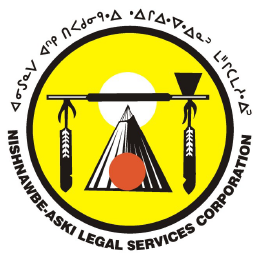
A Symbol of Unity
The Nishnawbe-Aski Legal Services symbol combines the traditional elements of the Aboriginal community with those of the EuroCanadian tradition.
Designer Roy Kakegamic weaves a scales of justice theme into the symbol using a balancing peace pipe. The pipe is recognized as the historical sacred symbol for bringing understanding between different people. The peace pipe is balanced on a tipi, which is the ancestral symbol for the home.
On each side of the tipi is a feather hanging from the peace pipe. One side of the tipi is coloured white and the other side black symbolizing the need for understanding of the two sides of every story. In the middle of the tipi is a red opening, an open invitation to the coming together of both sides.
The three elements: the peace pipe, tipi and feathers are contained in a circle – the circle of life – without beginning or end. This creates the fourth element in the design. Each of these elements represents one of the four directions of the compass. This theme is repeated again in the four sacred colours in the symbol: red, yellow, white and black.